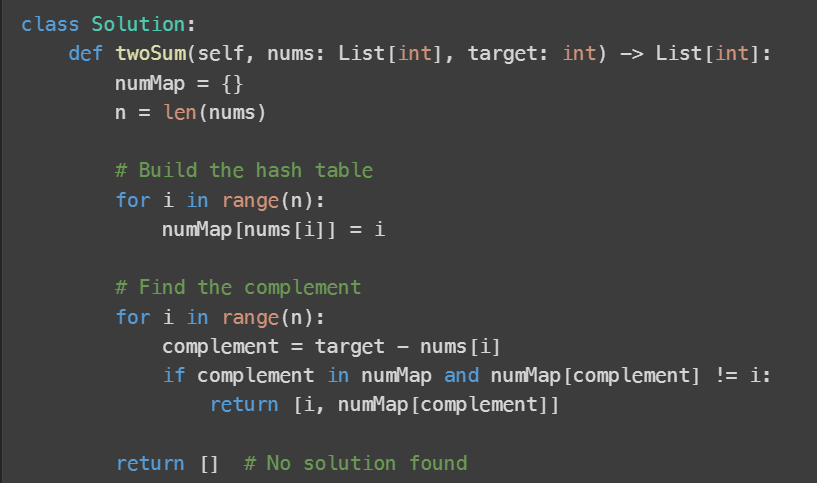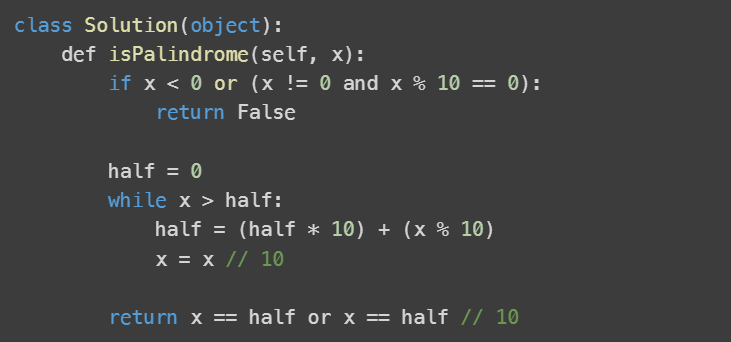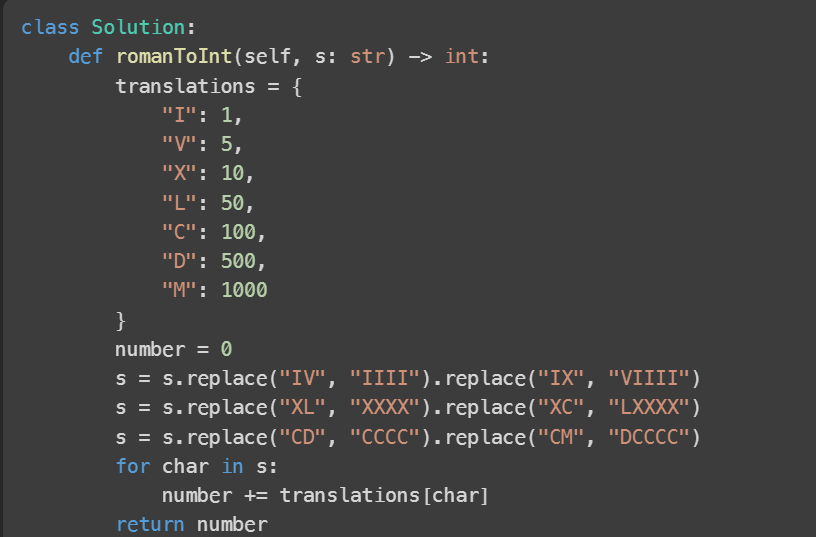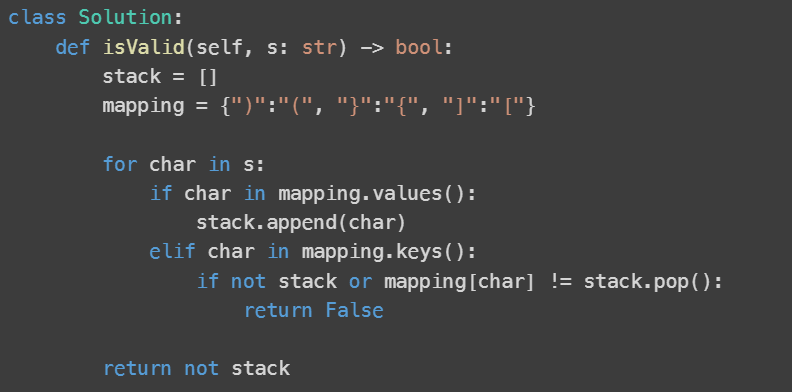Mastering Development in Python: Assignment 1 | Python- Mastering Development in Python - Software Development PDF Download
Q1: Given an array of integers nums and an integer target, return indices of the two numbers such that they add up to target.
You may assume that each input would have exactly one solution, and you may not use the same element twice.
You can return the answer in any order.
Example 1:
Input: nums = [2,7,11,15], target = 9
Output: [0,1]
Explanation: Because nums[0] + nums[1] == 9, we return [0, 1].
Example 2:
Input: nums = [3,2,4], target = 6
Output: [1,2]
Example 3:
Input: nums = [3,3], target = 6
Output: [0,1]
Constraints:
2 <= nums.length <= 104
-109 <= nums[i] <= 109
-109 <= target <= 109
Ans:
Intuition
The Two Sum problem asks us to find two numbers in an array that sum up to a given target value. We need to return the indices of these two numbers.
Approach
- One brute force approach is to consider every pair of elements and check if their sum equals the target. This can be done using nested loops, where the outer loop iterates from the first element to the second-to-last element, and the inner loop iterates from the next element to the last element. However, this approach has a time complexity of O(n^2).
- A more efficient approach is to use a hash table (unordered_map in C++). We can iterate through the array once, and for each element, check if the target minus the current element exists in the hash table. If it does, we have found a valid pair of numbers. If not, we add the current element to the hash table.
Approach using a hash table:
- Create an empty hash table to store elements and their indices.
- Iterate through the array from left to right.
- For each element nums[i], calculate the complement by subtracting it from the target: complement = target - nums[i].
- Check if the complement exists in the hash table. If it does, we have found a solution.
- If the complement does not exist in the hash table, add the current element nums[i] to the hash table with its index as the value.
- Repeat steps 3-5 until we find a solution or reach the end of the array.
- If no solution is found, return an empty array or an appropriate indicator.
- This approach has a time complexity of O(n) since hash table lookups take constant time on average. It allows us to solve the Two Sum problem efficiently by making just one pass through the array.
Code:
Brute Force Approach:

Solution 2: (Two-pass Hash Table)

Q2:
Given an integer x, return true if x is a palindrome , and false otherwise.
Example 1:
Input: x = 121
Output: true
Explanation: 121 reads as 121 from left to right and from right to left.
Example 2:
Input: x = -121
Output: false
Explanation: From left to right, it reads -121. From right to left, it becomes 121-. Therefore it is not a palindrome.
Example 3:
Input: x = 10
Output: false
Explanation: Reads 01 from right to left. Therefore it is not a palindrome.
Constraints:
-231 <= x <= 231 - 1
Code:

Q3: Roman numerals are represented by seven different symbols: I, V, X, L, C, D and M.
Symbol Value
I 1
V 5
X 10
L 50
C 100
D 500
M 1000
For example, 2 is written as II in Roman numeral, just two ones added together. 12 is written as XII, which is simply X + II. The number 27 is written as XXVII, which is XX + V + II.
Roman numerals are usually written largest to smallest from left to right. However, the numeral for four is not IIII. Instead, the number four is written as IV. Because the one is before the five we subtract it making four. The same principle applies to the number nine, which is written as IX. There are six instances where subtraction is used:
I can be placed before V (5) and X (10) to make 4 and 9.
X can be placed before L (50) and C (100) to make 40 and 90.
C can be placed before D (500) and M (1000) to make 400 and 900.
Given a roman numeral, convert it to an integer.
Example 1:
Input: s = "III"
Output: 3
Explanation: III = 3.
Example 2:
Input: s = "LVIII"
Output: 58
Explanation: L = 50, V= 5, III = 3.
Example 3:
Input: s = "MCMXCIV"
Output: 1994
Explanation: M = 1000, CM = 900, XC = 90 and IV = 4.
Constraints:
1 <= s.length <= 15
s contains only the characters ('I', 'V', 'X', 'L', 'C', 'D', 'M').
It is guaranteed that s is a valid roman numeral in the range [1, 3999].
Code: 
Q4: Write a function to find the longest common prefix string amongst an array of strings.
If there is no common prefix, return an empty string "".
Example 1:
Input: strs = ["flower","flow","flight"]
Output: "fl"
Example 2:
Input: strs = ["dog","racecar","car"]
Output: ""
Explanation: There is no common prefix among the input strings.
Constraints:
1 <= strs.length <= 200
0 <= strs[i].length <= 200
strs[i] consists of only lowercase English letters.
Ans:
- This code implements the longestCommonPrefix function that takes a list of strings v as input and returns the longest common prefix of all the strings. Here is an explanation of how the code works:
- Initialize an empty string ans to store the common prefix.
- Sort the input list v lexicographically. This step is necessary because the common prefix should be common to all the strings, so we need to find the common prefix of the first and last string in the sorted list.
- Iterate through the characters of the first and last string in the sorted list, stopping at the length of the shorter string.
- If the current character of the first string is not equal to the current character of the last string, return the common prefix found so far.
- Otherwise, append the current character to the ans string.
- Return the ans string containing the longest common prefix.
- Note that the code assumes that the input list v is non-empty, and that all the strings in v have at least one character. If either of these assumptions is not true, the code may fail.
Code:
Q5: Given a string s containing just the characters '(', ')', '{', '}', '[' and ']', determine if the input string is valid.
An input string is valid if:
Open brackets must be closed by the same type of brackets.
Open brackets must be closed in the correct order.
Every close bracket has a corresponding open bracket of the same type.
Example 1:
Input: s = "()"
Output: true
Example 2:
Input: s = "()[]{}"
Output: true
Example 3:
Input: s = "(]"
Output: false
Constraints:
1 <= s.length <= 104
s consists of parentheses only '()[]{}'.
Ans: 
|
8 videos|5 docs
|
FAQs on Mastering Development in Python: Assignment 1 - Python- Mastering Development in Python - Software Development
| 1. What are the key concepts of Python development? |  |
| 2. How can I improve my Python coding skills? |  |
| 3. What is the significance of unit testing in Python development? |  |
| 4. How can I optimize the performance of my Python applications? |  |
| 5. What are some best practices for Python development? |  |





















